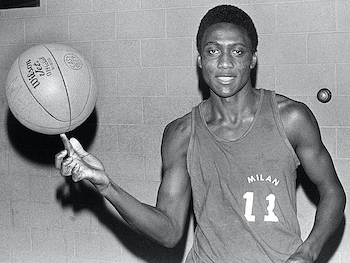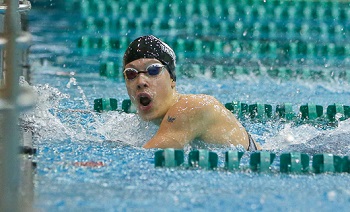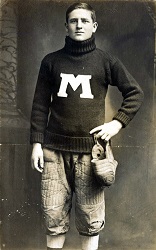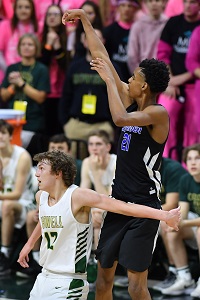
Joplin Always Has Known Value of Home
By
Doug Donnelly
Special for MHSAA.com
July 9, 2020
It is no accident that Stan Joplin has never ventured too far from his hometown of Milan on the border of Monroe and Washtenaw Counties in extreme southeast Michigan.
 In fact, that has been by design.
In fact, that has been by design.
“Mr. (Phil) Barnes once told me that you never want to get too far from home,” Joplin said recently, recalling one of his high school administrators. “If you are close by your home, people will remember you.”
It has been more than 40 years since Joplin played basketball at Milan, and no one is forgetting him anytime soon.
A coach at the high school and Division I collegiate levels and then high school again over nearly 40 years, the 63-year-old Joplin is two seasons removed from his last tenure leading the program at Sylvania Southview. But those decades of wisdom continue to be passed on to Southview students as Joplin serves as an assistant principal at the high school.
“The farthest I ever lived from Milan was when I was coaching at Kent State,” he said. “I’ve remained in southeast Michigan or northwest Ohio all of these years. I have been very fortunate to have the opportunity to stay close to home and receive a good education. You can’t put a price on education. Sooner or later, basketball was going to come to an end.”
It gave him a running start at the beginning.
One of the first four-year starters in Monroe County Region history, Joplin grew up around the game. People like Barnes, coach Ron Dingman and Ann Arbor’s Sandy Sanders all played key roles in Joplin’s early success.
Barnes was a mentor, offering advice and some key life lessons. Dingman was the coach who inserted Joplin into the starting lineup as soon as he could and kept him there as he led the Big Reds in scoring and was named team MVP four consecutive seasons. Sanders was a local basketball guru with connections from Ann Arbor to Detroit.
“Mr. Sanders was umpiring a baseball game and saw me shooting over at the elementary school,” Joplin said. “He invited me to come up to Ann Arbor to play.”
Sanders saw the basketball talent in Joplin and put him on the court in Ann Arbor with other prep talent and some University of Michigan players.
“That’s where I met guys like Campy Russell and Joe Johnson,” Joplin said.
Sanders took area players – including Joplin – to Detroit to play at the famed St. Cecilia Gym. St. Cecilia is well-known in basketball circles for hosting standouts like George Gervin, Magic Johnson and, more recently, Jalen Rose.
“You can imagine what kind of eye-opening experience that was,” Joplin said. “It showed me how hard I had to work. That was huge for me. That really exposed me to basketball.”
Growing up, his neighbor played basketball at Milan, and Joplin would get to go to all the games to watch him. Joplin read about Milan and other local basketball players in the Ypsilanti Press, Ann Arbor News and Monroe News, soaking up everything he could about the game.
“I just wanted to be an athlete,” he said.
He was more than just an athlete. An all-stater, he scored more than 1,500 career points – still a Milan record – and was recruited to play at the University of Toledo for Bobby Nichols.
 “It was the perfect situation,” Joplin said of growing up where he did. “Milan was a small town. A lot of the students I went to elementary school with I spent my whole time in school with. I knew everyone in the city.”
“It was the perfect situation,” Joplin said of growing up where he did. “Milan was a small town. A lot of the students I went to elementary school with I spent my whole time in school with. I knew everyone in the city.”
At Toledo, Joplin blossomed into an all-around player with a knack for elevating his game during key moments. He was named second team all-Mid-American Conference in 1977-78 and 1978-79. The 1979 Rockets won the MAC championship and made the NCAA Tournament. It was there that Joplin had the biggest moment of his career when he knocked down a 20-foot jumper to beat Iowa, 74-72, in the first round. The Rockets would lose a close game in the second round to a Notre Dame team that included four future NBA players. During Joplin’s four years at Toledo, the Rockets went 82-27.
While making national headlines, Joplin also was earning his education, something that Barnes encouraged along the way.
“I followed in his footsteps, went to college, got my degree and went into administration,” Joplin said.
After graduating from UT’s College of Education in 1979, Joplin began coaching at the high school level and was soon head coach at Toledo Start High School. He went on to become an assistant at Kent State University then joined the Rockets’ coaching staff during which time he earned a Master of Administration degree. He would later join the Michigan State University staff with Jud Heathcote and Tom Izzo.
In 1996, Joplin was named head coach at his alma mater, where he remained for 12 years, going 203-155 overall and making the NIT field four times. After he was let go following the 2007-08 campaign, Joplin reached into his education background to become an administrator in the Toledo area. He probably could have landed an assistant coaching job somewhere because of his connections in the sport, but chose not to go that route. He remained close to home.
He coached for a few seasons at Holland (Ohio) Springfield and one year at Sylvania Southview but is enjoying being a basketball fan these days.
“Basketball is the one thing I’ve done my whole life. I miss coaching, but I don’t need it,” he said.
Joplin goes to most of the Southview games and will go on the road occasionally to watch games in which some of his former players are coaching. He gets back to Michigan State University every now and then to watch the Spartans practice and relishes friendships he’s made in the game with people like former University of Michigan head coach Tommy Amaker and former Boston College head coach Al Skinner.
“I’ve got a lot of close friends that I stay in touch with,” he said.
He is not ruling out a return to the sidelines, but is not planning on it, either.
“I watch a lot of basketball. The game has changed,” he said. “The 3-point shot has taken the center out of the game. But, the game itself, is fine.”
Joplin is in the hallways more than the gym these days at Southview. His students know more about Mr. Joplin the school administrator than Stan Joplin the legendary basketball player from Milan – and he is fine with that.
“Every once in a while, someone will say something or bring me a video and say, ‘Hey, Mr. Joplin, I didn’t know you played.’ I just tell them that’s not me, that is just some guy with a lot more hair. It’s become kind of a running joke.”
Made in Michigan 2020
June 24: Fracassa's Remarkable Records Still Rule - Read
June 16: Muskegon Grad Casts "Magic" in HBO Series - Read
 Doug Donnelly has served as a sports and news reporter and city editor over 25 years, writing for the Daily Chief-Union in Upper Sandusky, Ohio from 1992-1995, the Monroe Evening News from 1995-2012 and the Adrian Daily Telegram since 2013. He's also written a book on high school basketball in Monroe County and compiles record books for various schools in southeast Michigan. E-mail him at [email protected] with story ideas for Jackson, Washtenaw, Hillsdale, Lenawee and Monroe counties.
Doug Donnelly has served as a sports and news reporter and city editor over 25 years, writing for the Daily Chief-Union in Upper Sandusky, Ohio from 1992-1995, the Monroe Evening News from 1995-2012 and the Adrian Daily Telegram since 2013. He's also written a book on high school basketball in Monroe County and compiles record books for various schools in southeast Michigan. E-mail him at [email protected] with story ideas for Jackson, Washtenaw, Hillsdale, Lenawee and Monroe counties.
PHOTOS: (Top) Milan basketball legend Stan Joplin serves as an assistant principal at Sylvania Southview High School. (Middle) Joplin still owns the career scoring record at Milan.

2018-19 Stacking Up With Best on Records
March 29, 2019
By Ron Pesch
Special for Second Half
What a sports year.
There certainly have been some amazing athletic feats over the 2018-19 high school season in Michigan, and it’s just two-thirds of the way complete.
This past fall, Kobe Clark of Schoolcraft scored nine touchdowns in a single game. Stunning!
The winter sports season saw Dylan Jergens of Marcellus Howardsville Christian top the MHSAA single season scoring record in boys basketball, finishing with 971 points. Incredible!
Then a freshman, Emoni Bates, hits for 31 points in an MHSAA Semifinal for Ypsilanti Lincoln. Wow!
So, how does that compare to years past?
First, let’s hit the pool!
SWIMMING
Across the world, as well as in Michigan, record performances seem to fall regularly in swimming. I’m certainly no expert on the sport, but research seems to indicate that optimization of stroke count, kicks and other body positioning (and not a change in the density of H2O) impact the lowering of recorded times in the water. The continued synchronization and optimization of movement may mean we’ll see regular improvement for years to come.
It’s telling that MHSAA all class/division records in eight of the 12 events that make up a girls meet have been set this decade. The remaining four marks date to 2002 or 2007, and are held by Kara Lynn Joyce of Ann Arbor Pioneer or Allison Schmitt of Canton. Joyce, of course, went on to post 18 NCAA championships and four silver medals won during three Olympic competitions. A freestyle specialist, Schmitt won eight Olympic medals across the 2008, 2012 and 2016 games.
 This past fall, the triumphs of three athletes, in particular, stand out. Kathryn Ackerman set a new state mark in the 200 individual medley with a time of 1:57:25. A junior, Ackerman’s time should place nationally in the top 15 all-time. With the 2018 season complete, she now holds the top four times in the event according to the MHSAA record book.
This past fall, the triumphs of three athletes, in particular, stand out. Kathryn Ackerman set a new state mark in the 200 individual medley with a time of 1:57:25. A junior, Ackerman’s time should place nationally in the top 15 all-time. With the 2018 season complete, she now holds the top four times in the event according to the MHSAA record book.
Senior Ashley Turak sprinted to a new Division I record of 22.10 in the 50 freestyle for Harrison/Farmington on the first leg of the 200 freestyle relay, as well as a time of 22.20 in the 50 freestyle. Both those times also rank in the national record books within the top 15. The MHSAA All-Class/Division Final Meet mark still belongs to Joyce, who posted a time of 22.04, set while leading off the 200 freestyle relay team in the Class A 2002 preliminaries.
Turak again mesmerized the crowd, this time in the 100-yard freestyle, posting a time of 48.72 seconds to win the event. Again, Joyce holds the Michigan All-Class/Division mark with a then-national record time of 48:59 set in 2002.
This November, Grand Ledge junior Lola Mull fell less than a half-second short of her own state mark in the 500-yard freestyle, set in the 2017 preliminaries. Mull owns the state’s top three times in the event, while Schmitt ranks fourth on the list.
Sub 20
A winter sport in Michigan, boys swimming is no different, with records in 10 of the 12 events set in the 2010s. Cam Peel of Spring Lake became the first in state history to break 20 seconds in the 50-yard freestyle, accomplishing the milestone twice this March, first in the prelim race with a record time of 19.86 and again in the finals at 19.91. The marks surpassed the previous best, set by Henry Schutte of Grand Rapids Forest Hills Central one year ago, and also rank among the “Best of the Best” in the National Federation record book.
FOOTBALL
Clark’s nine touchdowns came in Schoolcraft’s 63-27 victory over previously undefeated Constantine in a Southwestern Athletic Conference contest. Thanks to steady rain in the first half, Schoolcraft stuck to the ground game, opening a 21-0 first quarter lead on three Clark touchdowns, one of eight yards, the second of 24, and the third of 10 yards. Constantine battled back to within eight points, 21-13 late in the second quarter, but Clark would score for Schoolcraft twice more during the final three minutes before halftime.
 Following a 24-yard scamper, a partially blocked punt would set up Clark’s fifth rushing TD from two yards out with under a minute remaining before the break. (This appears to be a great moment to note that five players have scored five touchdowns in a single quarter). Clark added two TDs in the third quarter and two in the fourth.
Following a 24-yard scamper, a partially blocked punt would set up Clark’s fifth rushing TD from two yards out with under a minute remaining before the break. (This appears to be a great moment to note that five players have scored five touchdowns in a single quarter). Clark added two TDs in the third quarter and two in the fourth.
Amazingly, Clark’s nine touchdowns and 54 points scored are not state records. In fact, two others have matched the touchdown and point count, while three others have exceeded the accomplishment in each category. Of course, each of those events occurred at least 90 years ago, decades before the introduction of the mercy rule in high school football.
For many years, Herb Dunphy was listed as the state’s record holder for a pair of seemingly untouchable records: touchdowns in a single game and points scored in a game. In 1917 he scored 10 TDs for Lansing Central and stood alone at the top.
But as time has proven again and again, the work of historians and researchers can alter what we believe. In 1986, research by Tom Pellow of Gwinn uncovered that Marmaduke “Duke” Christie of Escanaba had also scored 10 touchdowns, matching Dunphy’s output. In addition, Christie added six point-after-touchdowns that day, totaling 66 points, as Escanaba defeated Ishpeming 102-0 in November 1920.
“In my humble opinion, Escanaba high school in 1920 had one of the greatest football teams that ever misunderstood a signal in any language,” wrote Cy DeLynes, recalling the exploits of Christie and his teammates in the Escanaba Daily Press in 1929. “Christie was its captain. The Duke had a pair of collapsible ankles and he was able to play in only a part of four games. That, however, was just enough time to permit him to score 21 touchdowns and 38 out of a possible 50 points after touchdown – a total of 164 points. He led a backfield that made Knute Rockne’s Four Horsemen look like a quartet of super-annuated milk wagon drivers turning off the alarm clocks at 4 o’clock in the morning.”
A few years later, additional study of yearbooks and newspapers revealed the exploits of Cecil Hardy of Flint Central, again reshaping the scoring entries in the MHSAA record book.
In the 1914 season opener – a 106-0 blasting of Lapeer – Hardy carried for more than 300 yards. Within the first two minutes of play, the captain of the Flint squad had scored the first of 11 touchdowns – a “new” state mark.
“His end running was the feature of the game, his longest run being one for 50 yards and a touchdown on the first play after the kickoff. Time after time as he was making his long runs he appeared to be tackled and would wriggle out of the grasp of his opponent and run 15 or 20 yards further,” was the report of the day.
“How Is This For Football?”
Muskegon 216, Hastings 0
The Boston Globe paired the question with the football score from a Michigan high school game to readers in their Sunday edition back on September 29, 1912.
“Most of Muskegon’s touchdowns were scored on the kick-off,” stated the Globe, “and few required more than one down.”
The score was believed to be a “world’s record” for points scored in a game, at the time. Indeed, the total ranks as the tops in Michigan. Indeed, it was a record nationally, but would be surpassed on three occasions in the coming years, first in 1923, again in 1924 and finally in 1927. With today’s employment of the running clock, the scoring totals will never again be approached.
The score was 40-0 at the end of the first quarter, 102-0 following the second, and 150-0 after three quarters. Touchdowns were scored by nine different players, with six scoring multiple times. As byproducts, captain Fred Jacks finished with nine touchdowns, while Muskegon’s Nelson Stuit booted 24 of 30 extra points in the contest (another state mark that also will never be equaled).
“Although world’s records fell in the game it is not anything to be particularly proud of …” stated the Muskegon Chronicle in the prose of the time. “The visitors had about three men that knew a football from an eff, and those three could not make the Muskegon second team.”
One of the best, as it turned out, was Fred Rehor, Hastings’ “big 220 pound fullback” who would later play for Michigan, then professional ball in Ohio for the 1917 Massillon Tigers, coached by Knute Rockne.
 As a result of the Muskegon-Hastings game, “at least three of the football elevens which contracted this year to meet Muskegon high school have begun to make excuses in line with those usually offered before a team quits such an engagement,” wrote the Lansing State Journal. Muskegon rolled up 499 points on the year, but ended a flawless season in defeat, 13-12 against rival Grand Rapids Central in the finale. The loss was blamed on overconfidence.
As a result of the Muskegon-Hastings game, “at least three of the football elevens which contracted this year to meet Muskegon high school have begun to make excuses in line with those usually offered before a team quits such an engagement,” wrote the Lansing State Journal. Muskegon rolled up 499 points on the year, but ended a flawless season in defeat, 13-12 against rival Grand Rapids Central in the finale. The loss was blamed on overconfidence.
The aptly named Francis Tallent of Menominee, became the next player to score nine TDs in a game.
Tallent’s skills on the gridiron had been spotted in 1928.
“Standing out like a missing tooth in a front row of the chorus … (Tallent) revealed as speedy a pair of heels as one could ever hope to cast his optics on in a high school game,” wrote one reporter after witnessing the left halfback’s performance in the annual twin cities battle between Menominee and Marinette, Wis., then played on Armistice day. Tallent scored twice in that “M & M” game, a 26-0 win by Menominee.
After thumping Green Bay in its 1929 season opener and a “helpless” Oshkosh Normal (now known as the University of Wisconsin-Oshkosh) freshmen team, 46-6, Menominee squared off for its game against “a light and green squad” from Kingsford.
According to the Milwaukee Journal Sentinel, Tallent scored nine touchdowns that day on runs of 46, 72, 90, 64, 50, 37, 90, 85 and 63 yards. In total, the paper noted that Tallent gained 597 yards rushing in the 150-0 thrashing of Kingsford. Other sources noted that it was likely more, as the sum of only the TD runs equaled the 597 yard total. Kingsford would finish its seven-game season without scoring a point. According to the Kingsfordian, the school’s high school annual, the Kingsford players “were no match for the heavier and more experienced teams on the range” that school year.
Menominee’s success and Tallent’s football exploits prompted the Journal-Sentinel to send a reporter to the U.P. to cover the 1929 M & M game between the border schools later that fall. “Mr. Tallent, who runs like the well-known hare and who slips out of tacklers’ arms and hands like a piece of wet soap, scored four touchdowns in the course of the afternoon,” wrote the staffer. “All told, this Mr. Tallent rolled up 284 yards,” as the “pride of the peninsula walloped Marinette,” 49-0, before a crowd of 10,000. The score was “the highest ever piled up in 45 years of bitter rivalry between the two cities.”
Menominee ended the 1929 season undefeated and untied in eight games, scoring over a point-a-minute while claiming the Upper Peninsula championship and demanding statewide consideration for Michigan’s mythical crown. Tallent finished the season with 27 touchdowns.
BASKETBALL
After 35 years, one began to wonder if Mark Brown’s single-season scoring mark, set in 1984-85 during his days at Hastings, would ever be surpassed. Brad Redford, named Michigan’s Mr. Basketball, came close as a senior in 2007-08, falling 17 points shy of exceeding Brown’s total of 969. Prior to that, only Drew Neitzel of Wyoming Park had come within reasonable striking distance, but that happened a decade and a half ago.
This year, Jergens of Howardsville Christian finally topped the total, finishing with 971 points. Jergens accomplished the task in 24 games, two games fewer than Brown, but with the advantage of the 3-point shot. The three was implemented after Brown had headed to college. According to press reports, Jergens had four games of at least 50 points during the season.
Still standing, 40 years later, is Jay Smith’s high school career scoring mark of 2,841 points, set at Mio between 1976 and 1979. Jergens finished third on the list with 2,782 career points, including 320 career 3-pointers – second most in state history. Brown ranks second with 2,789 points scored between 1982 and 1985.
 Freshmen
Freshmen
Few followers of prep basketball in Michigan could avoid coming across the name Emoni Bates, especially after the freshman phenom from Ypsilanti Lincoln knocked down 17 points in the Quarterfinals, 31 points in the Semifinal round of the Division 1 tournament, then 23 in the championship game. The immediate question on press row was, “Had another ninth grader ever exceeded his totals in a MHSAA final-rounds contests?” There was nothing to exceed it that I could recall.
While we’ve kept final round records, including single-game scoring marks, the website minimum is 40 points, and we’ve never captured a list that’s broken down by year in school.
So, I decided to dig.
Quarterfinals
The state has certainly seen some talented freshmen pass through the last rounds of the tournament. Monte Morris scored 20 points in the Quarterfinals for Flint Beecher during its Class C run in 2010. Saginaw Buena Vista played two freshmen, Mark Macon and Shawn Randolph, along its route to the Finals in 1984. Macon, at the age of 14, scored 22 points in a Quarterfinal win over Menominee that season. Two players scored 24 points in the quarters as freshmen: Flint Beecher’s Roy Marble, Jr. in 1982 in a loss to Okemos and Manton’s Matt Stuck, who scored 24 in defeat against Mio in 1989. But, according to Detroit Free Press accounts, it appears Michael Payton from Detroit St. Leo is the leading freshman point-getter in the Quarterfinal round. Payton netted 26 in a 74-62 loss to Flint St. Redeemer in the 1970 tournament.
Semifinals
Macon in 1984 and perhaps the most famous of freshmen in MHSAA Tournament history, Willie Betts of River Rouge in 1961, both scored 14 in Semifinal victories. Clyde Corley from Pontiac Central tossed in 16 points during a heartbreaking Semifinal defeat, 53-52, to Saginaw in 1976. Kelvin Torbert posted 17 points (and 10 rebounds) in a 65-62 Semifinal loss to Belleville in 1998. Morris tallied 18 in a loss to Melvindale Academy for Business & Technology in the Class C semis in 2010. So, Bates’ total of 31 certainly appears to top the list.
Finals
Only one freshman prior to Bates has hit for double digits in a state final. In 1992, Saginaw Buena Vista’s Terrance Roberson went 3 for 7 from the field and 4 for 7 from the free throw line to finish with 10 points as the Knights grabbed a 54-44 win over Grandville Calvin Christian.
Please, let me know if I missed a top performer.
 Ron Pesch has taken an active role in researching the history of MHSAA events since 1985 and began writing for MHSAA Finals programs in 1986, adding additional features and "flashbacks" in 1992. He inherited the title of MHSAA historian from the late Dick Kishpaugh following the 1993-94 school year, and resides in Muskegon. Contact him at [email protected] with ideas for historical articles.
Ron Pesch has taken an active role in researching the history of MHSAA events since 1985 and began writing for MHSAA Finals programs in 1986, adding additional features and "flashbacks" in 1992. He inherited the title of MHSAA historian from the late Dick Kishpaugh following the 1993-94 school year, and resides in Muskegon. Contact him at [email protected] with ideas for historical articles.
PHOTOS: (Top) Grand Haven’s Kathryn Ackerman swims the breaststroke portion of her record-setting 200-yard individual medley this past fall. (Top middle) Harrison-Farmington’s Ashley Turak looks to the clock after her 100 freestyle at the Lower Peninsula Division 1 Finals. (Middle) Schoolcraft’s Kobe Clark. (Middle below) Muskegon's Fred Jacks. (Below) Ypsilanti Lincoln’s Emoni Bates fires a jumper during his team’s Division 1 Semifinal win over Howell

